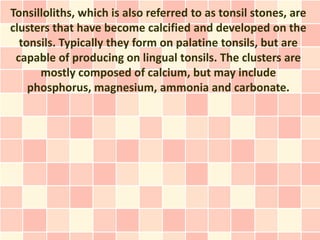
Tonsil Stones: Causes and Treatments
- 1. Tonsilloliths, which is also referred to as tonsil stones, are clusters that have become calcified and developed on the tonsils. Typically they form on palatine tonsils, but are capable of producing on lingual tonsils. The clusters are mostly composed of calcium, but may include phosphorus, magnesium, ammonia and carbonate.
- 2. Tonsils are located in the back of the throat and gland like in structure. There is one located on each side of the throat in a pocket. These structures are made from tissue that has lymphocytes, the cells that fight and prevent infections. These parts are known for playing a major role in the immune system and are designed to act as nets that trap virus and bacteria particles from passing into the throat.
- 3. This condition may have no symptoms, but is often associated with pain when swallowing and bad breath. It is more common for adults to have this issue than children. Typically when the stones are small, they do not produce extreme symptoms. Even when they are big, they may only be discoverable by CAT scans or X-rays. Other common symptoms: throat tightening or closing, choking, fits of coughing and metallic taste.
- 4. In larger cases, multiple symptoms may be present. One symptom is recurrent halitosis, which is often present with sore throat, tonsil infection, bad taste in the throat, problems swallowing, tonsil swelling, ear ache and white debris. The exact cause for this condition is unknown.
- 5. These stones are calcifications that develop in tonsil crypts. They may also develop in the throat or on the roof area of the mouth. Tonsils include numerous crevices that can be breeding ground for bacteria, dead cells, mucus and other materials. When this happens, the debris may turn into the white formations. Tonsilloliths are formed when the trapped material combines and hardens. This problem is likely to develop in those who suffer with chronic tonsil inflammation or repeated cases of tonsillitis.
- 6. Usually treatment is not required. This is because most cases of this condition are not accompanied with major, or any, symptoms. But there are four key types of treatment issued in severe cases. They are: surgery, laser, irrigation and curettage. The process of laser resurfacing, or laser cryptolysis, involves lowering the surface area of tonsils. This practice is normally done with the patient under local anesthetic. In the procedure known as curettage, tissue is removed using a curette. This is more common for big stones.
- 7. Irrigation is a basic but effective practice the involves use of oral irrigators to remove stones and clean nearby crypts. Often irrigators are not used for stone removal because they have a high amount of power that can be dangerous for the tonsils and uncomfortable for patients. Surgery, called tonsillectomy, is often a last resort option that involves the complete removal of one or both tonsils.
- 8. Tonsil stones, also known as tonsilloliths, is a condition that develops within tonsils. Bacteria and other harmful elements becoming lodged in crannies and nooks of the tonsils is the most common cause for the problem. In some cases, this condition will go away without treatment, but there are care options for severe cases.